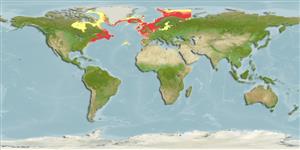Preferred temperature (Αναφ.
123201): 0.6 - 11.4, mean 7.1 °C (based on 732 cells).
Phylogenetic diversity index (Αναφ.
82804): PD
50 = 1.0000 [Uniqueness, from 0.5 = low to 2.0 = high].
Bayesian length-weight: a=0.02630 (0.01091 - 0.06342), b=2.99 (2.77 - 3.21), in cm total length, based on LWR estimates for this (Sub)family-body shape (Ref.
93245).
Τροφικό Επίπεδο (Αναφ.
69278): 3.9 ±0.0 se; based on diet studies.
Ελαστικότητα (Αναφ.
120179): Χαμηλό, ελάχιστος χρόνος για διπλασιασμό πληθυσμού 4,5 - 14 έτη (K=0.12; tm=3-5; tmax=13; Fec=100,000).
Prior r = 0.15, 95% CL = 0.10 - 0.22, Based on 1 full stock assessment.
Fishing Vulnerability (Ref.
59153): Moderate to high vulnerability (47 of 100).
🛈
Climate Vulnerability (Ref.
125649): Low to moderate vulnerability (26 of 100).
🛈
Nutrients (Ref.
124155): Calcium = 14 [4, 76] mg/100g; Iron = 0.419 [0.153, 1.089] mg/100g; Protein = 14 [11, 18] %; Omega3 = 0.423 [0.162, 1.406] g/100g; Selenium = 26.2 [8.8, 69.4] μg/100g; VitaminA = 13.4 [2.4, 72.4] μg/100g; Zinc = 0.52 [0.20, 0.90] mg/100g (wet weight); based on
nutrient studies. 